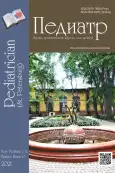Comparison of different gastrostomy tubes materials resistance to the effects of damaging factors in vitro model experiment
- Authors: Gavshchuk M.V.1, Zorin I.M.2, Vlasov P.S.2, Lisovskii O.V.1, Gostimsky A.V.1, Sarkisyan Z.M.1, Zavyalova A.N.1, Kabanov A.V.1, Kuznetsova Y.V.1, Karpatsky I.V.1, Lisitsa I.A.1
-
Affiliations:
- St. Petersburg State Pediatric Medical University
- Saint Petersburg State University
- Issue: Vol 12, No 5 (2021)
- Pages: 47-52
- Section: Original studies
- URL: https://journals.eco-vector.com/pediatr/article/view/104990
- DOI: https://doi.org/10.17816/PED12547-52
- ID: 104990
Cite item
Abstract
Background. A variety of products made from different materials (natural latex, silicone, silicone-coated latex, polyvinyl chloride, polyurethane and other) are used as gastrostomy tubes. They have different resistance to damaging factors, different microbial landscape and timing of infection. The aim of investigation is to compare the resistance of various gastrostomy tubes materials to the effects of damaging factors in an in vitro model experiment.
Materials and methods. The experiment was performed with 2 latex urinary N 34 Pezzer catheters, 2 latex silicone-coated urinary 26 Fr Foley catheters, 2 polyurethane 18 Fr nasogastric tubes, 2 silicone 24 Fr branded gastrostomy tubes for percutaneous endoscopic bumper-type installation. All the tubes were cut on to 5 sections 50 mm long, weighed, marked at the ends and placed in a sealed vessels with 40 ml of water for 14 days at a temperature of 36°C. After that, the tube fragments were wiped with filter paper, re-weighed and measured. Similar pieces of tubes 50 mm long were weighed and placed in a 0.1 M hydrochloric acid solution for 14 days at a temperature of 36°C, followed by repeated measurements. After the experiment, the samples were washed with distilled water and dried at 70°C for a day, followed by measurement.
Results. The change in the mass and linear dimensions of the polyurethane and silicone tubes were negligible (0.1–0.5%) after the influence of water and a solution of hydrochloric acid. Changes in latex and latex with silicone coating tubes were significant, the mass changed by 2–12% due to water absorption, the length – by 1–3.5%. For latex materials, a decrease of 1% in mass was noted after drying. Decrease in linear dimensions of polyurethane materials was a result of exposure to elevated temperatures.
Conclusions. According to the results of the model experiment, silicone and polyurethane tubes showed the least absorption of liquids, changes in weight and length, which indicates their resistance to damaging factors in the experiment and allows us to recommend products made from these materials for gastrostomy. Latex catheters have demonstrated maximum fluid accumulation, weight and length changes, which makes their use in clinical practice impractical.
Full Text
About the authors
Maksim V. Gavshchuk
St. Petersburg State Pediatric Medical University
Email: gavshuk@mail.ru
MD, PhD, Cand. Sci. (Med.), Associate Professor, Department of General Medical Practice
Russian Federation, Saint PetersburgIvan M. Zorin
Saint Petersburg State University
Email: i.zorin@spbu.ru
MD, PhD, Cand. Sci. (Chemistry), Associate Professor, Department of High Molecular Chemistry
Russian Federation, Saint PetersburgPetr S. Vlasov
Saint Petersburg State University
Email: p.vlasov@spbu.ru
Junior Researcher, Department of High Molecular Chemistry
Russian Federation, Saint PetersburgOleg V. Lisovskii
St. Petersburg State Pediatric Medical University
Email: oleg.lisowsky@yandex.ru
MD, PhD, Cand. Sci. (Med.), Associate Professor, Head, Department of General Medical Practice
Russian Federation, Saint PetersburgAlexander V. Gostimsky
St. Petersburg State Pediatric Medical University
Email: gostimsky@mail.ru
MD, PhD, Dr. Sci. (Med.), Professor, Head, Department of Hospital Surgery with Traumatology and Military Surgery Courses
Russian Federation, Saint PetersburgZara M. Sarkisyan
St. Petersburg State Pediatric Medical University
Email: zara-sark@inbox.ru
MD, PhD, Cand. Sci. (Chemistry), Head, Associate Professor, V.V. Horunzhego Department of General and Medical Chemistry
Russian Federation, Saint PetersburgAnna N. Zavyalova
St. Petersburg State Pediatric Medical University
Email: anzavjalova@mail.ru
MD, PhD, Cand. Sci. (Med.), Associate Professor, Department of General Medical Practice
Russian Federation, Saint PetersburgAleksandr V. Kabanov
St. Petersburg State Pediatric Medical University
Email: alk979@yandex.ru
PhD, Cand. Sci. (Chem.), Associate Professor, V.V. Horunzhego Department of General and Medical Chemistry
Russian Federation, Saint PetersburgYulia V. Kuznetsova
St. Petersburg State Pediatric Medical University
Email: u-piter@mail.ru
MD, PhD, Cand. Sci. (Med.), Associate Professor, Department of General Medical Practice
Russian Federation, Saint PetersburgIgor V. Karpatsky
St. Petersburg State Pediatric Medical University
Email: ikar122@list.ru
MD, PhD, Cand. Sci. (Med.), Associate Professor, Department of General Medical Practice
Russian Federation, Saint PetersburgIvan A. Lisitsa
St. Petersburg State Pediatric Medical University
Author for correspondence.
Email: ivan_lisitsa@mail.ru
MD, Assistant Professor, Department of General Medical Practice
Russian Federation, Saint PetersburgReferences
- Gostimskiy AV, Gavshchuk MV, Zav’yalova AN, et al. Features nutrition support and nursing of patients with gastrostomy. Medicine: Theory and Practice. 2018;3(2):3–10. (In Russ.)
- Luft VM, Lapitskii AV, Sergeeva AM. Spravochnik po klinicheskomu pitaniyu. Saint Petersburg: OOO RA Russkii Yuvelir, 2018. 368 p. (In Russ.)
- Campoli P, Cardoso D, Turchi M, Mota O. Clinical trial: a randomized study comparing the durability of silicone and latex percutaneous endoscopic gastrostomy tubes. Digestive Endoscopy. 2011;23(2):135–139. doi: 10.1111/j.1443-1661.2010.01051.x
- Gottlieb K, Mobarhan S. Review: microbiology of the gastrostomy tube. J Am Coll Nutr. 1994;13(4):311–313. doi: 10.1080/07315724.1994.10718415
Supplementary files













